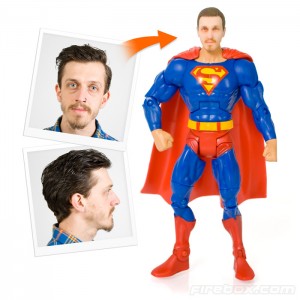 The title of this post is borrowed from a book of short stories by Thomas M. Disch, and it’s doubly appropriate in that an act of borrowing arguably lies at the heart of the latest 3D-printing novelty to catch my eye: a British company called Firebox will take pictures of your own head, turn them into a 3D-printed noggin, and stick it on a superhero body. As readers of this blog probably know, I’m intrigued by desktop-fabrication technologies less for their ability to coin unique inventions (the “rapid prototyping” side of their operations) and more for the interesting wrinkles they introduce to the production and circulation of licensed and branded objects — especially fantasy objects, which are referentially unreal but tightly circumscribed by designs associated with particular franchises. Superhero bodies are among the purest examples of such artifacts, offering immediately recognizable physiologies and costumes such as Batman, Superman, and Wonder Woman; all of which are among the bodies onto which you can slap your replacement head.
The title of this post is borrowed from a book of short stories by Thomas M. Disch, and it’s doubly appropriate in that an act of borrowing arguably lies at the heart of the latest 3D-printing novelty to catch my eye: a British company called Firebox will take pictures of your own head, turn them into a 3D-printed noggin, and stick it on a superhero body. As readers of this blog probably know, I’m intrigued by desktop-fabrication technologies less for their ability to coin unique inventions (the “rapid prototyping” side of their operations) and more for the interesting wrinkles they introduce to the production and circulation of licensed and branded objects — especially fantasy objects, which are referentially unreal but tightly circumscribed by designs associated with particular franchises. Superhero bodies are among the purest examples of such artifacts, offering immediately recognizable physiologies and costumes such as Batman, Superman, and Wonder Woman; all of which are among the bodies onto which you can slap your replacement head.
Aside from literalizing the dual-identity structure that has always offered us mild-mannered Clark Kents a means of climbing into Kryptonian god-suits, what I love about this is its neat encapsulation of the deeper ideological function of the 3D-printed fantasy object, giving people the opportunity not just to locate themselves amid an array of mass produced yet personally significant forms (as in, for example, a collection of action figures) but to materialize themselves within and as part of that array, through plastic avatars that also serve as a kind of cyborg expression of commercialized subjectivity. That Firebox (and, presumably, license-holder DC Comics) currently offer a controlled version of that hybridity is only, I think, a symptom of our prerevolutionary moment, poised at the brink of an explosion of such transmutations and transubstantiations, legal and illegal alike, though which the virtual and material objects of fantastic media will not just swap places but find freshly bizarre combinatorial forms.
